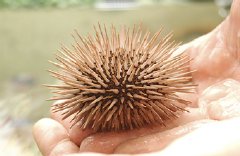May 4 2009
Sea urchins dig themselves hiding holes in the limestone of the ocean floor using teeth that don’t go blunt. Weizmann Institute scientists have now revealed their secrets, which might give engineers insights into creating ever-sharp tools or mechanical parts.

The urchins dig holes to fit their globular bodies using their five teeth, which, like those of rodents, are ground down at the tip but continue to grow on the other end throughout the animals’ lives. The amazing part, however, is that the teeth, which need to be harder and stronger than the rocky limestone being dug out, are themselves made almost entirely of calcite – the same calcite that makes up much of the limestone. How is this possible? In a series of studies spanning more than a decade, Profs. Steve Weiner and Lia Addadi of Weizmann’s Structural Biology Department have discovered that the urchins’ secret lies in a combination of ingenious design strategies. The latest of these studies, conduc ted with postdoctoral fellow Yurong Ma and graduate student Yael Politi and in collaboration with Prof. Pupa Gilbert and Dr. Rebecca Metzler of the University of Wisconsin, Drs. Barbara Aichmayer, Oskar Paris and Peter Fratzl from the Max Planck Institute of Colloids and Interfaces in Potsdam, Germany, and Dr. Anders Meibom from Museum National D’Histoire Naturelle in Paris, France, was reported recently in the Proceedings of the National Academy of Sciences (PNAS), USA.
The scientists found that the sea urchins’ teeth contain crystals of magnesium calcite, which are smaller, harder and denser than those of pure calcite; they are concentrated at the grinding tip of the tooth, particularly in the tip’s center, where the most force is being exerted in the course of grinding. What holds these crystals at the center of the tip is a matrix of larger and softer calcite crystals. While in most such materials a matrix of hard fibers contains a softer filling, the reverse is true for the urchins’ tooth: a matrix of relatively soft calcite fibers holds the harder magnesium calcite crystals, which allows these crystals to spread over the entire surface of the tooth. The presence of magnesium calcite crystals acts like sand paper that helps to grind the rock down.
In the latest study, the researchers used X-ray photoelectron emission spectromicroscopy and other high-resolution imaging methods to uncover yet another amazing structural feature of sea urchin tooth design. They found that all the crystalline elements that make up the tooth are aligned in two different arrays, and that these arrays are ‘interdigitated,’ or interlocked like the fingers of folded hands, just at the tip of the tooth where most of the wear occurs. The scientists believe that interlocking produces a notched, serrated ridge resembling that of a carpenter’s file. This ridge is self-sharpening: as the tooth is being ground down, the crystalline layers break in such a way that the ridge always stays corrugated.
Prof. Lia Addadi’s research is supported by the Clore Center for Biological Physics; the Ilse Katz Institute for Material Sciences and Magnetic Resonance Research; the Helen and Martin Kimmel Center for Nanoscale Science; the Helen and Milton A. Kimmelman Center for Biomolecular Structure and Assembly; and the Carolito Stiftung. Prof. Addadi is the incumbent of the Dorothy and Patrick Gorman Professorial Chair.
Prof. Stephen Weiner’s research is supported by the Kekst Family Center for Medical Genetics; the Helen and Martin Kimmel Center for Archaeological Science; the Helen and Milton A. Kimmelman Center for Biomolecular Structure and Assembly; and the estate of George Schwartzman. Prof. Weiner is the incumbent of the Dr. Walter and Dr. Trude Borchardt Professorial Chair in Structural Biology.